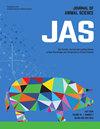饲养期不同饲粮添加策略对Nelore小母牛体重的影响及对青春期诱导方案的响应
IF 2.9
2区 农林科学
Q1 AGRICULTURE, DAIRY & ANIMAL SCIENCE
引用次数: 0
摘要
小母牛需要特别关注,因为它们对能量和营养的需求很高,而背景阶段往往与旱季重合,持续几个月。在此期间,饲料生产力和营养成分下降。体重增加可能受到牧场质量和可用性以及未来种畜性早熟的影响。在这方面,本研究旨在评估背景补充剂对体重(BW)、青春期年龄和青春期诱导方案反应的影响。选用64头断奶内洛尔小母牛(~8月龄,270 kg),采用完全随机设计,根据饲养阶段饲粮添加水平分为4个处理:T1 -低(矿物量- 0.03 g/kg体重)、T2 -边缘(0.3 g/kg体重)、T3 -中(0.6 g/kg体重)和T4 -高(0.9 g/kg体重)。试验期为7个月,分别于试验开始、中期和结束时测定动物的活重。在12和14个月时进行生殖评估,根据黄体(CL)的存在或不存在来评估青春期状态。在最终评估后,采用基于黄体酮(D-0)和雌二醇(D-14)的激素方案进行青春期诱导。24天后,对方案反应进行分析。由表1可知,第一次称重时,四组体重相同。第二次称重时,T4的体重明显高于T1 (p = 0.04)。最终称重时,处理显著影响体重,T1低于其他各组(p <;与T2相比,T4的平均体重最高(p = 0.003)。在第一次生殖评估时,没有一头小母牛进入青春期。第二次评价时,3只动物(2只来自T3, 1只来自T4)进入青春期,处理间无显著差异(p >;0.05)。在青春期诱导方案下,64头小母牛中有46头(71.9%)进入青春期,不同处理之间无显著差异(p >;0.05)。然而,在T1和T2之间观察到一种趋势(p = 0.0652)。体重数据使用R中的“lm”函数进行分析,认为治疗是模型中唯一的固定效应。对于黄体(CL)的存在,“glm”函数用于逻辑模型(二元特征)。补充剂对体重有直接影响;然而,在青春期年龄或对青春期诱导方案的反应方面,治疗之间没有发现显著差异。在背景阶段,高水平的补充会导致体重增加。本文章由计算机程序翻译,如有差异,请以英文原文为准。
164 Different supplementation strategies during the rearing phase and their effects on the body weight and the response to puberty induction protocol in Nelore heifers
Heifers require special attention due to their high energy and nutritional demands, and the backgrounding phase often coincides with the dry season for several months. During this period, forage productivity and nutritional composition decline. Weight gain can be influenced by both the quality and availability of pastures, as well as the sexual precocity of the future breeding stock. In this regard, this research aims to evaluate the impact of supplementation during backgrounding on body weight (BW), age at puberty, and response to a puberty induction protocol. Sixty-four weaned Nellore heifers (~8 months old, 270 kg) were assigned to a completely randomized design and subjected to four treatments based on the level of supplementation during the rearing phase: T1 – Low (Mineral - 0.03 g/kg of BW), T2 – Marginal (0.3 g/kg of BW), T3 – Medium (0.6 g/kg of BW), and T4 – High (0.9 g/kg of BW). The phase lasted 7 months, during which the live weight of the animals was evaluated at the beginning, middle, and end of the phase. Reproductive evaluations were conducted at 12 and 14 months to assess puberty status based on the presence or absence of a Corpus Luteum (CL). Following the final evaluation, a progesterone (D-0) and estradiol (D-14) based hormonal protocol was applied for puberty induction. After 24 days, an analysis of the protocol response was performed. According to Table 1, at the first weighing, the four groups had the same weight. By the second weighing, T4 had a significantly higher weight than T1 (p = 0.04). At the final weighing, treatment significantly influenced body weight, with T1 being lower than all other groups (p < 0.001) and T4 showing the highest average weight compared to T2 (p = 0.003). At the first reproductive evaluation, none of the heifers had reached puberty. By the second evaluation, three animals (two from T3 and one from T4) were pubertal, with no significant difference between treatments (p > 0.05). Following the puberty induction protocol, 46 out of 64 heifers (71.9%) reached puberty, with no significant differences between treatments (p > 0.05). However, a tendency was observed between T1 and T2 (p = 0.0652). Body weight data were analyzed using the ‘lm’ function in R, considering treatment as the sole fixed effect in the model. For the presence of the Corpus Luteum (CL), the ‘glm’ function was used for a logistic model (binary trait). Supplementation had a direct impact on body weight; however, no significant differences were found between treatments regarding age at puberty or response to the puberty induction protocol. A high level of supplementation resulted in greater body weight gain during the backgrounding phase.
求助全文
通过发布文献求助,成功后即可免费获取论文全文。
去求助
来源期刊

Journal of animal science
农林科学-奶制品与动物科学
CiteScore
4.80
自引率
12.10%
发文量
1589
审稿时长
3 months
期刊介绍:
The Journal of Animal Science (JAS) is the premier journal for animal science and serves as the leading source of new knowledge and perspective in this area. JAS publishes more than 500 fully reviewed research articles, invited reviews, technical notes, and letters to the editor each year.
Articles published in JAS encompass a broad range of research topics in animal production and fundamental aspects of genetics, nutrition, physiology, and preparation and utilization of animal products. Articles typically report research with beef cattle, companion animals, goats, horses, pigs, and sheep; however, studies involving other farm animals, aquatic and wildlife species, and laboratory animal species that address fundamental questions related to livestock and companion animal biology will be considered for publication.
 求助内容:
求助内容: 应助结果提醒方式:
应助结果提醒方式:


